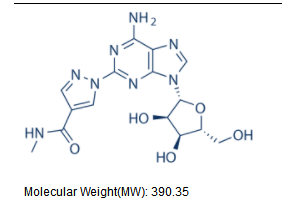Products
Regadenoson 313348-27-5
| 1.Inquiries will be replied within 24 hours |
| 2.We could supply various packages as you required |
| 3.To protect the profit of our agents, price will not show on website, please send inquiries to get the price. |
| 4.Fast delivery, goods arrive your office within 3 to 5 days |
| 5.Please click "Inquiry" or "Email" below to get the price |
 |
|
|
||||||
|
C15H18N8O5 |
|
|||||
|
390.35 |
|
in stock | ||||
|
313348-27-5 |
|
98%+ |
Introduction
Regadenoson has a relatively low binding affinity (hA2A Ki=290 nM) for human A2A receptors and greater than 30-fold selectivity versus the A2B and A3AR subtypes and 13-fold over the A1AR. Regadenoson behaves as a weak partial agonist causing cAMP accumulation in PC12 cells but as a full and potent agonist causing coronary vasodilation
In a dog model, intravenous bolus injection of regadenoson causes a dose-dependent increase in myocardial blood flow and a dose-dependant decrease in coronary vascular resistance. In a rat heart model, regadenoson was shown to have a dose-dependent increase in heart rate and a decrease in mean arterial pressure at the higher doses. Regadenoson also caused more than a 2-fold increase in serum norepinephrine and epinephrine. For clinical data, Regadenoson has a volume of distribution of 11.5 L and 78.7 L (at steady-state), and an estimated clearance of 37.8 L/h. It is renally excreted (58% of total elimination) with a terminal half-life of 33 to 108 min
Products for scientific research use only
In a dog model, intravenous bolus injection of regadenoson causes a dose-dependent increase in myocardial blood flow and a dose-dependant decrease in coronary vascular resistance. In a rat heart model, regadenoson was shown to have a dose-dependent increase in heart rate and a decrease in mean arterial pressure at the higher doses. Regadenoson also caused more than a 2-fold increase in serum norepinephrine and epinephrine. For clinical data, Regadenoson has a volume of distribution of 11.5 L and 78.7 L (at steady-state), and an estimated clearance of 37.8 L/h. It is renally excreted (58% of total elimination) with a terminal half-life of 33 to 108 min
Products for scientific research use only






